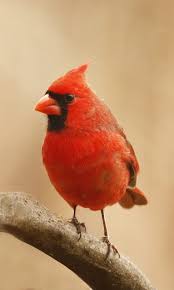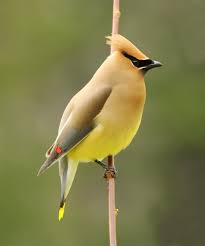by DJ Featherton




Yes, I know, we’re all looking for spectacular birds at our backyard feeders. Bright red Northern Cardinals, black and orange Baltimore Orioles, Blue Jays and summer-time Goldfinches all make the list of favorites. A topper on my list, however, is true Art from the Heavens, the Cedar Waxwing. These special birds don’t have a lot of splashy color, but their unique markings make the Waxwing one of the most favored birds to watch and photograph.


The Cedar Waxwing is a sleek bird of 6 1/2 to 8 inches in length. The adult is a light grayish brown color and sports a fine crest and a sharp black mask over the eyes and chin. His undertail is white with a yellow band at the tip. The Waxwing’s unique feature, however, is a shiny red tag at his secondary wing feathers that look like wax., Hence, the name: Cedar Waxwing. With his silky feathers, contrasting colors, dashing black mask and fine royal crest, this bird is a true prince of the backyard birds.
The Cedar Waxwing may be more common than some think. Their breeding range is from Canada through the northern half of the U.S. They winter in the southern U.S. and as far south as South America. In the Northwest and in parts of the Northeast, Waxwings will stay the year. Although berries are their preference, in summer months they eat a full menu of insects that include just about everything! In the fall and winter these voracious feeders migrate in flocks of about forty or more and can devour the entire fruit or flower pedals from a single tree in short order. Waxwings are very social, and it’s common to see them feeding each other. It’s also said that they can become a bit intoxicated from fermenting berries. I guess they like to wine and dine! Seeing a flock of these beautiful birds all feeding in a single berry producing tree is a spectacle for anyone! Getting them to the backyard feeder is not always easy unless your yard has some junipers or cedars, holly, service or winterberries, crabapple or hawthorne or other berry and blossoming trees and shrubs. Otherwise, apple slices and other fruit pieces in a suet basket or on a platform feeder will work well if they find it. Adding a water source always helps as these voracious eaters also require lots of fresh drinking water. Even their nesting location will be close to a water source.



Here’s more about the Cedar Waxwing, he has a big brother that looks almost the same! The Bohemian Waxwing is only an inch or so longer but weighs in at nearly twice as much as his little brother. The Cedar Waxwing is a sleek and slender bird while the bohemian Waxwing is bigger and more round and bulky. Other differences are small. The Bohemian has a light pink blush on his face, and his undertail is a rusty orange as opposed to the bright white of the Cedar Waxwing. Here’s a big difference, Bohemians range is far north through Canada and Alaska. During winter there are some in the mountains of the Northwest and even some Midwestern states near Canada. Personally, I have never seen a Bohemian, but he certainly remains high on my wish list.

I’ve seen lots of Cedar Waxwings, but always by luck and by golly. You may just notice a single tree filled with birds. This can happen anywhere! Get close to watch. They’ll be so busy that you may not matter. They’re beautiful! Enjoy!
